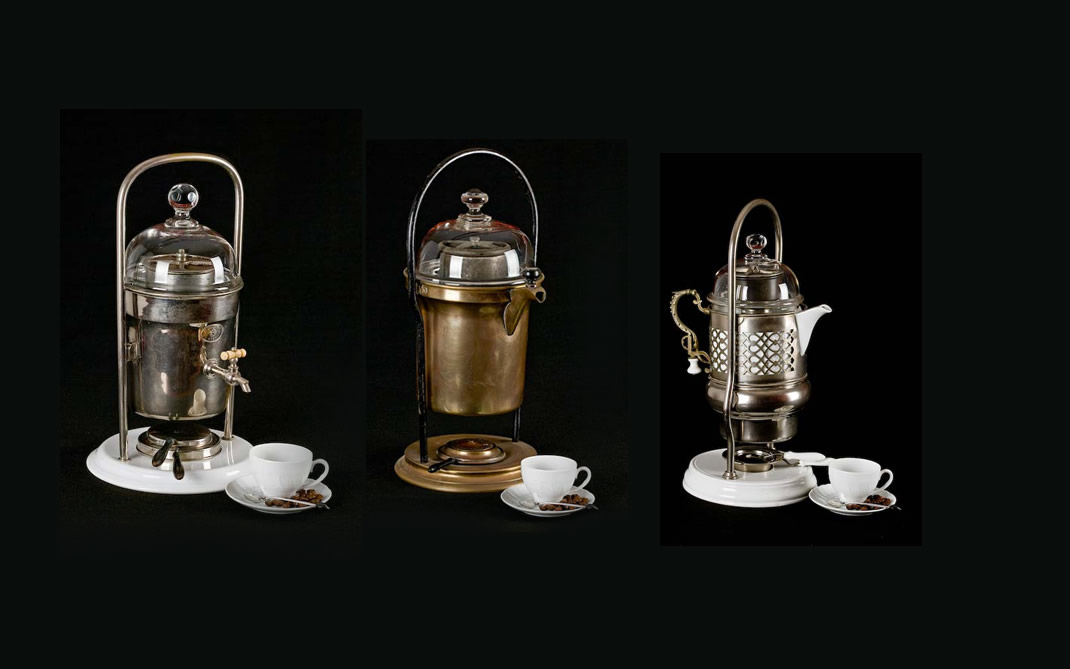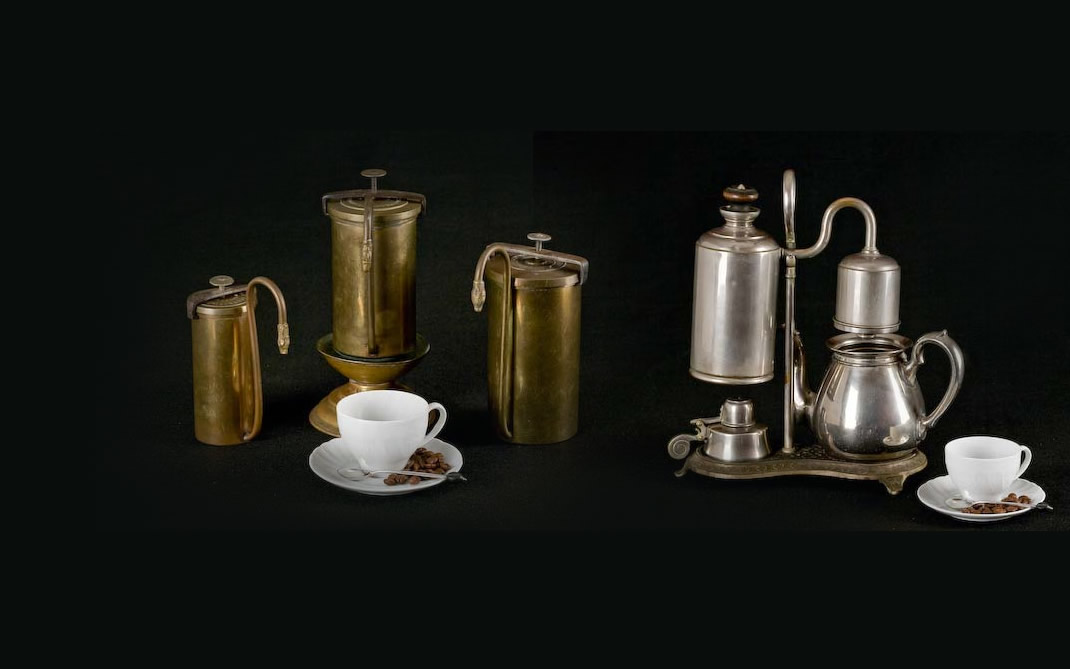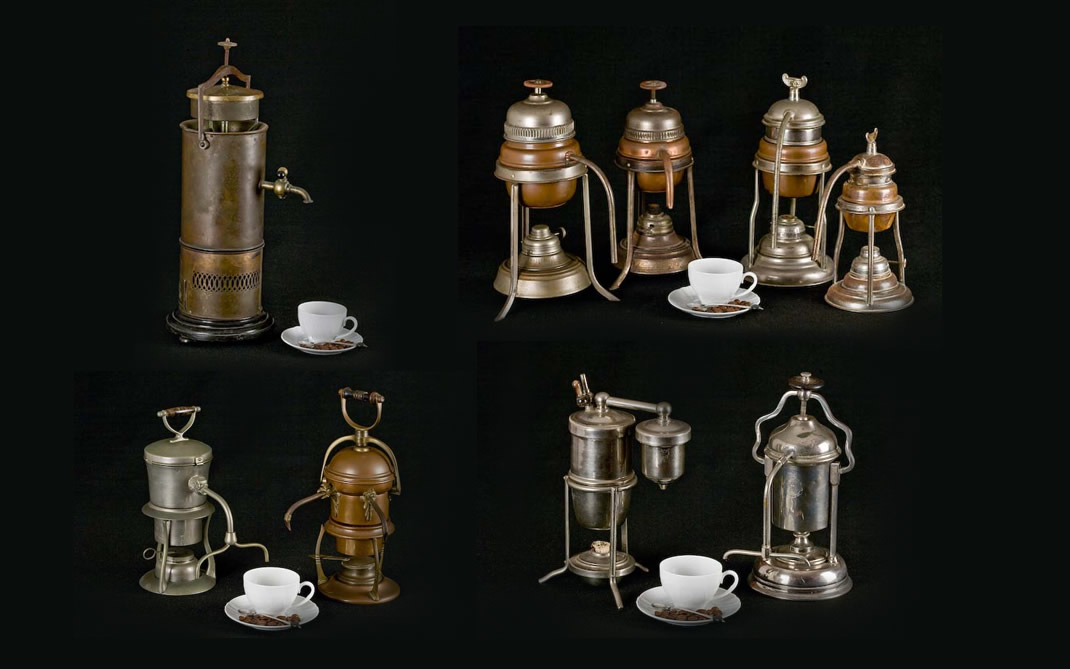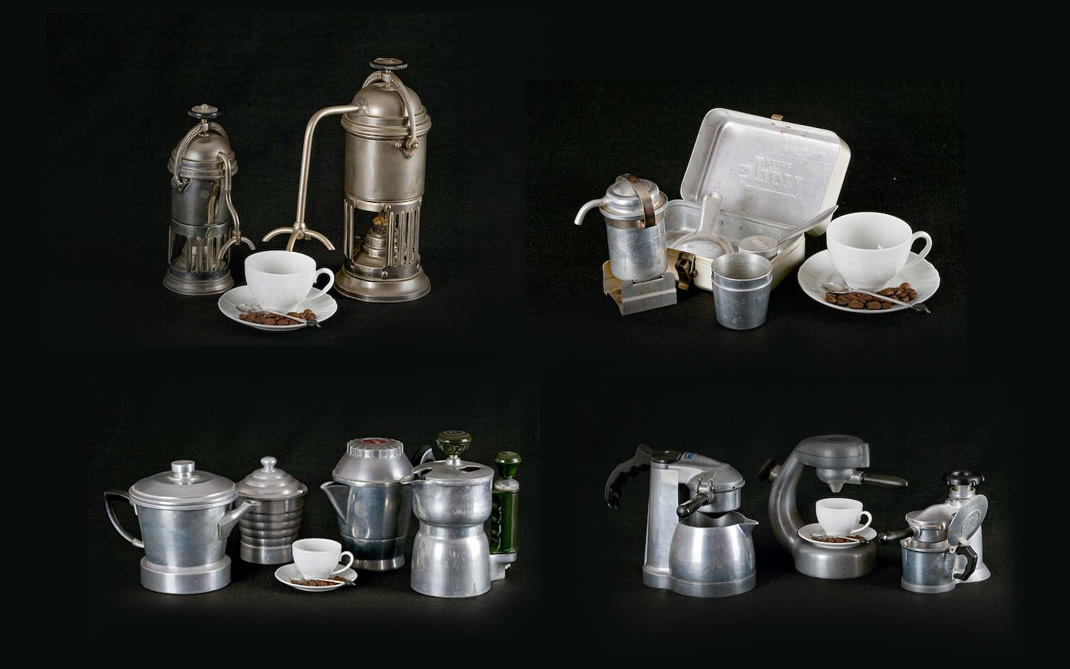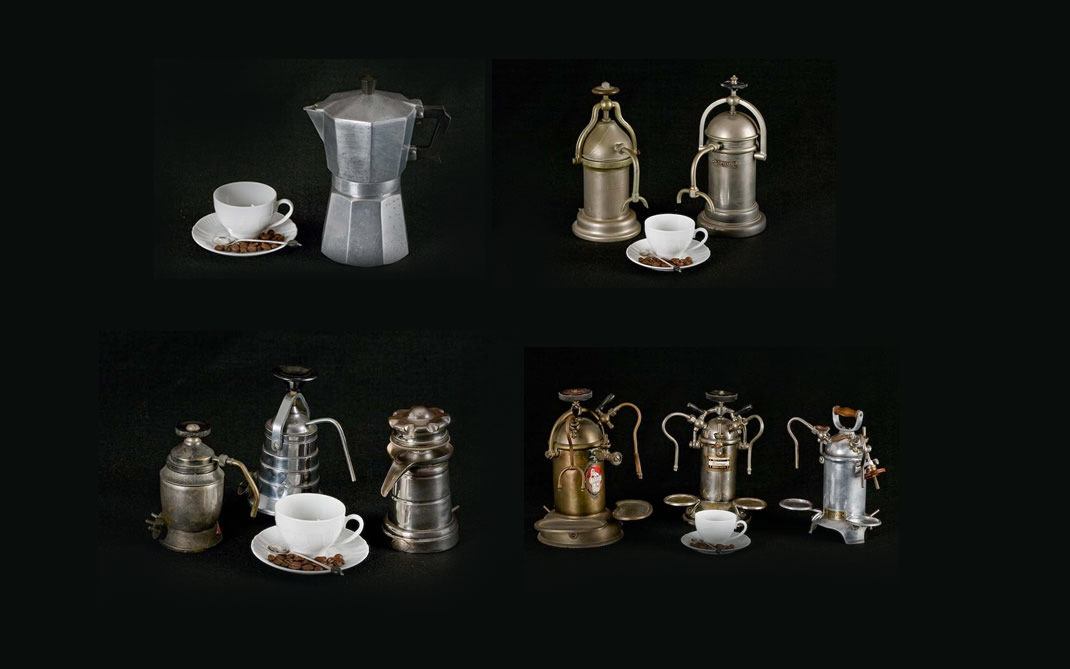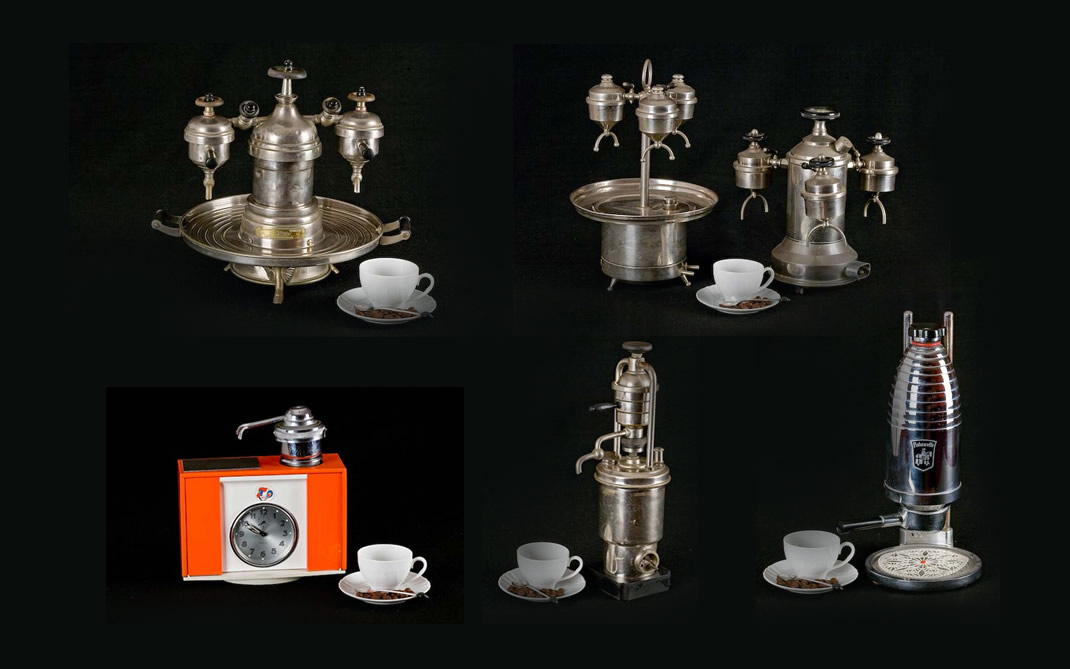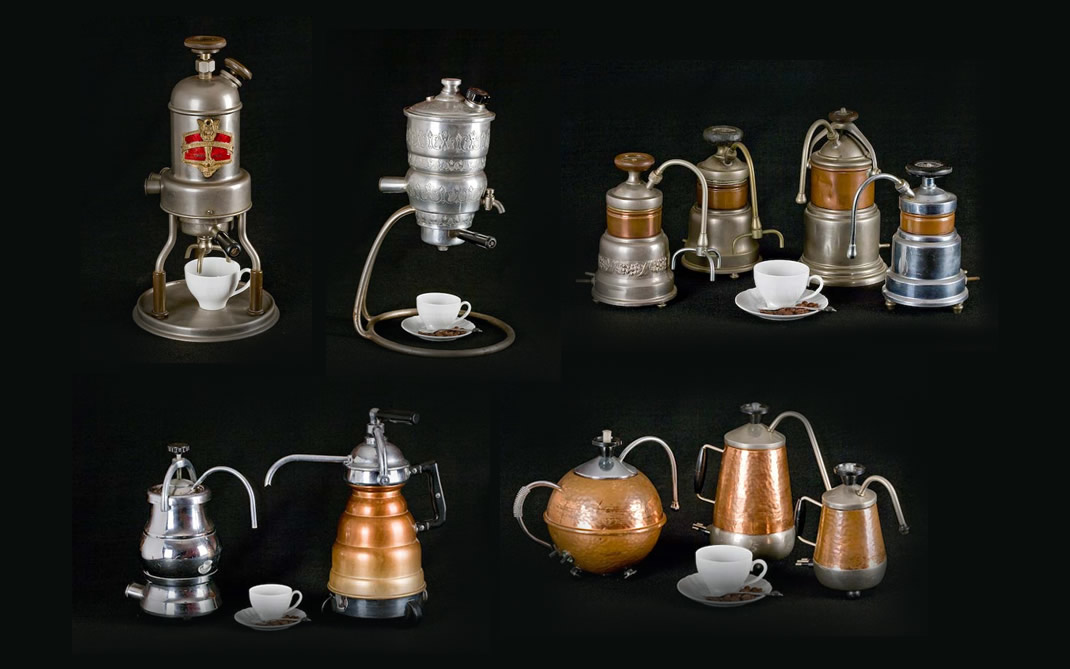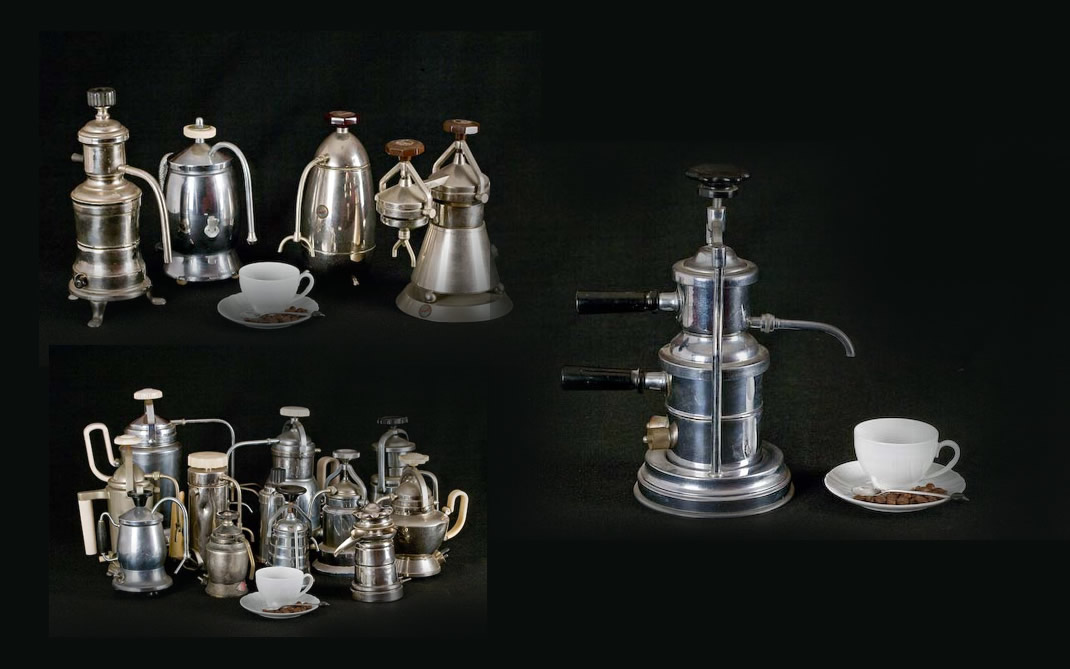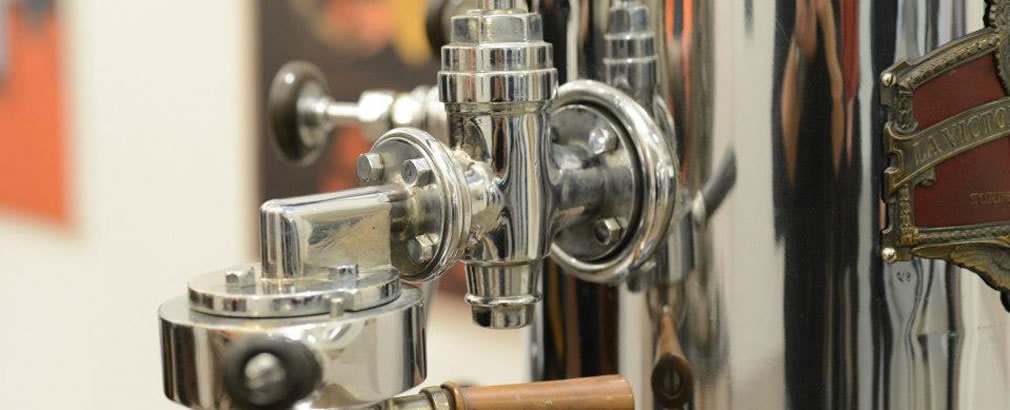Steam Pressure (‘long’ espresso)
Period: 1840 - 1900
System: Steam pressure
Various types and models of steam pressure coffee makers with spirit burners called Steam Fountain or also Vienna Incomparabile produced in Austria, Germany and England.
Although later renamed Vienna Incomparabile, the Steam Fountain coffee maker first appeared in England in 1833 and was made by London coppersmith Samuel Parker.
The cylindrical body of this model was often made of brass or copper (but also nickel-plated brass, Sheffield steel, silver or porcelain) and was split into two parts: the internal part (boiler) contained the water to be heated, whilst the external part (cavity) collected the coffee infusion and had a valve plug (at the bottom) or a spout (at the top).
These beautiful coffee makers worked as follows. The water heated by the spirit burner went up from the boiler to the filter containing the ground coffee through an internal tube.
The boiling water went through the filter with such force that the liquid hit the internal part of the glass dome and ran down the external part of the container creating a kind of fountain effect.
The coffee was poured out from here through a special tap or the spout by tipping up the coffee maker.
System: Steam pressure
Various types and models of steam pressure coffee makers with spirit burners called Steam Fountain or also Vienna Incomparabile produced in Austria, Germany and England.
Although later renamed Vienna Incomparabile, the Steam Fountain coffee maker first appeared in England in 1833 and was made by London coppersmith Samuel Parker.
The cylindrical body of this model was often made of brass or copper (but also nickel-plated brass, Sheffield steel, silver or porcelain) and was split into two parts: the internal part (boiler) contained the water to be heated, whilst the external part (cavity) collected the coffee infusion and had a valve plug (at the bottom) or a spout (at the top).
These beautiful coffee makers worked as follows. The water heated by the spirit burner went up from the boiler to the filter containing the ground coffee through an internal tube.
The boiling water went through the filter with such force that the liquid hit the internal part of the glass dome and ran down the external part of the container creating a kind of fountain effect.
The coffee was poured out from here through a special tap or the spout by tipping up the coffee maker.
Period: 1838
System: Steam pressure
Small brass coffee maker patented in Paris by Alexandre Lebrun in 1838. Steam pressure operation, it was fed by a spirit burner. The pressure of the steam pushing downwards rather than up was used by Lebrun for his small, ingeniously designed coffee maker. The ground coffee was pressed down using a pestle, in a box-shaped filter at the base of the coffee pot. The cold water was poured in from above. The lid was locked with a special clamp and the pot heated by the alcohol in a little plate at the base. In just four minutes the coffee was automatically poured into the cup through the finely worked spout.
Lebrun’s pressure machine was popular for decades and was used in Germany, Austria and Italy.
Period: 1878
System: Steam pressure
H. Eicke’s machine was patented in Berlin, Germany in 1878. Although the device was balancing and the burner had a self-extinguishing lid and it was very similar to the compensation siphons Balance system, the way it worked was completely different. In this case, the depression of the vacuum of the boiler was not used for filtering the coffee but rather the pressure of the steam which pushed the boiling water from the boiler to the filter containing the ground coffee. When all the water contained in the boiler had gone through the filter, the coffee maker tipped and the lid of the spirit burner dropped to put out the flame. In this way, the preparation cycle finished automatically.
System: Steam pressure
Small brass coffee maker patented in Paris by Alexandre Lebrun in 1838. Steam pressure operation, it was fed by a spirit burner. The pressure of the steam pushing downwards rather than up was used by Lebrun for his small, ingeniously designed coffee maker. The ground coffee was pressed down using a pestle, in a box-shaped filter at the base of the coffee pot. The cold water was poured in from above. The lid was locked with a special clamp and the pot heated by the alcohol in a little plate at the base. In just four minutes the coffee was automatically poured into the cup through the finely worked spout.
Lebrun’s pressure machine was popular for decades and was used in Germany, Austria and Italy.
Period: 1878
System: Steam pressure
H. Eicke’s machine was patented in Berlin, Germany in 1878. Although the device was balancing and the burner had a self-extinguishing lid and it was very similar to the compensation siphons Balance system, the way it worked was completely different. In this case, the depression of the vacuum of the boiler was not used for filtering the coffee but rather the pressure of the steam which pushed the boiling water from the boiler to the filter containing the ground coffee. When all the water contained in the boiler had gone through the filter, the coffee maker tipped and the lid of the spirit burner dropped to put out the flame. In this way, the preparation cycle finished automatically.
Period: 1880 - 1890
System: Steam pressure
Majestic in size with an original parts layout and elegant decorative motifs and materials, this large pressure machine had a spirit burner in the base. Produced by the company A. Gella in Milan. Coffee filtering could be observed through the filter at the top of the machine.
Period: 1910 - 1920
System: Steam pressure
Elegant, with refined finishes and valuable handcrafted decorations, these two Italian coffee makers produced by Invicta are made of copper-brass and nickel-plated brass and have spirit burners. Two cup capacity.
Period: 1920 - 1930
System: Steam pressure
On the left, the A.G. Oikos model in nickel-plated brass produced by Fratelli Carderoni in Milan. When the water was hot, the whistle signalled that it was time to turn the special tap in order to connect up the front filter containing the ground coffee.
On the right, the Ideale Espresso in nickel-plated brass, the very first model for home use produced by the well-known Desiderio Pavoni in Milan.
Period: 1910 - 1920
System: Steam pressure
Various steam pressure coffee makers, all made of copper and nickel-plated iron, with spirit burners, produced in Ferrara, Italy, by Fratelli Santini bearing the Aquilas brand and by Figli di Silvio Santini bearing the Orso brand. Two to six cup capacity. Operation of this small, charming machine for home use is simple and it is easy to use. The steam pressure pushes the hot water upwards through the coffee filter and the liquid is poured out from the front spout directly into the cups or a coffee pot.
System: Steam pressure
Majestic in size with an original parts layout and elegant decorative motifs and materials, this large pressure machine had a spirit burner in the base. Produced by the company A. Gella in Milan. Coffee filtering could be observed through the filter at the top of the machine.
Period: 1910 - 1920
System: Steam pressure
Elegant, with refined finishes and valuable handcrafted decorations, these two Italian coffee makers produced by Invicta are made of copper-brass and nickel-plated brass and have spirit burners. Two cup capacity.
Period: 1920 - 1930
System: Steam pressure
On the left, the A.G. Oikos model in nickel-plated brass produced by Fratelli Carderoni in Milan. When the water was hot, the whistle signalled that it was time to turn the special tap in order to connect up the front filter containing the ground coffee.
On the right, the Ideale Espresso in nickel-plated brass, the very first model for home use produced by the well-known Desiderio Pavoni in Milan.
Period: 1910 - 1920
System: Steam pressure
Various steam pressure coffee makers, all made of copper and nickel-plated iron, with spirit burners, produced in Ferrara, Italy, by Fratelli Santini bearing the Aquilas brand and by Figli di Silvio Santini bearing the Orso brand. Two to six cup capacity. Operation of this small, charming machine for home use is simple and it is easy to use. The steam pressure pushes the hot water upwards through the coffee filter and the liquid is poured out from the front spout directly into the cups or a coffee pot.
Period: 1910 - 1930
System: Steam pressure
Italian-made Adele and Stella coffee makers in nickel-plated brass. One to four cup capacity. Small travel and camping coffee makers are very compact and easy to use. The spirit burner and the cups are stored at the base of the coffee maker.
Period: 1950 - 1960
System: Steam pressure
Czechoslovak-made coffee maker bearing the Sport brand. Made in steel and aluminium, it has a two cup capacity and the burner is fed with fuel tablets. This coffee maker was ideal for camping and came in a special box containing all the necessary accessories (fuel tablets, small box for sugar and coffee, teaspoon and tongs for handling the boiling coffee pot) for preparing and tasting the coffee.
Period: 1950 - 1960
System: Steam pressure
Group of stove-top coffee makers produced in aluminium and Bakelite, sold in Italy after Bialetti’s Moka Express (on the left) debuted in the Fifties.
Period: 1950 - 1960
System: Steam pressure
Group of Italian stove-top coffee makers in aluminium. On the right, there is the characteristic Columbia Crème produced by OMG, steam pressure and pump coffee maker, with a six cup capacity. The pump in the handle makes it possible to increase the water pressure for extracting the coffee, making a larger quantity of coffee cream, or crema.
Period: 1950 - 1960
System: Steam pressure
Their original design led these aluminium and Bakelite stove-top coffee makers to become very popular in Italy at this time. From left to right: the Trimel, Atomic and Vesuviana, all produced by companies from Milan.
System: Steam pressure
Italian-made Adele and Stella coffee makers in nickel-plated brass. One to four cup capacity. Small travel and camping coffee makers are very compact and easy to use. The spirit burner and the cups are stored at the base of the coffee maker.
Period: 1950 - 1960
System: Steam pressure
Czechoslovak-made coffee maker bearing the Sport brand. Made in steel and aluminium, it has a two cup capacity and the burner is fed with fuel tablets. This coffee maker was ideal for camping and came in a special box containing all the necessary accessories (fuel tablets, small box for sugar and coffee, teaspoon and tongs for handling the boiling coffee pot) for preparing and tasting the coffee.
Period: 1950 - 1960
System: Steam pressure
Group of stove-top coffee makers produced in aluminium and Bakelite, sold in Italy after Bialetti’s Moka Express (on the left) debuted in the Fifties.
Period: 1950 - 1960
System: Steam pressure
Group of Italian stove-top coffee makers in aluminium. On the right, there is the characteristic Columbia Crème produced by OMG, steam pressure and pump coffee maker, with a six cup capacity. The pump in the handle makes it possible to increase the water pressure for extracting the coffee, making a larger quantity of coffee cream, or crema.
Period: 1950 - 1960
System: Steam pressure
Their original design led these aluminium and Bakelite stove-top coffee makers to become very popular in Italy at this time. From left to right: the Trimel, Atomic and Vesuviana, all produced by companies from Milan.
Period: 1960 - 1970
System: Steam pressure
Group of small, aluminium, stove-top Italian coffee makers which poured the coffee straight into the cups when it was ready.
Period: 1950
System: Steam pressure
One of the very first versions of the famous Moka Express produced by Alfonso Bialetti in Crusinallo and sold during the post-war period. It has a solid aluminium structure, is octagonal in shape and features a brass safety valve and rubber gasket between the boiler and pot. Produced in models of varying capacity, the Moka brought a radical change to how Italians drank coffee at home, offering them coffee with a new flavour and stronger, and ousting out the Napoletana coffee maker which was popular at the time. Still today, the Moka is considered an icon of Italian-made goods throughout the world.
Period: 1920 - 1930
System: Steam pressure
Italian coffee makers for families in nickel-plated brass produced in the shape of the column coffee makers for bars of the period. On the left, the Snider, on the right the La Pavoni, both from Milan.
Period: 1920 - 1930
System: Steam pressure
Three Italian-made Eterna coffee makers produced by the company Watt in Pavia. Made in nickel-plated brass and cast aluminium, they are shaped like the column bar machines of the period.
Period: 1920 - 1930
System: Steam pressure
Italian machines for families produced in brass and nickel-plated brass by Select Electric (on the left) and S.E.I. from Turin (on the right).
Period: 1920 - 1950
System: Steam pressure
Three small, one cup machines made in Italy in nickel or chrome plated brass.
System: Steam pressure
Group of small, aluminium, stove-top Italian coffee makers which poured the coffee straight into the cups when it was ready.
Period: 1950
System: Steam pressure
One of the very first versions of the famous Moka Express produced by Alfonso Bialetti in Crusinallo and sold during the post-war period. It has a solid aluminium structure, is octagonal in shape and features a brass safety valve and rubber gasket between the boiler and pot. Produced in models of varying capacity, the Moka brought a radical change to how Italians drank coffee at home, offering them coffee with a new flavour and stronger, and ousting out the Napoletana coffee maker which was popular at the time. Still today, the Moka is considered an icon of Italian-made goods throughout the world.
Period: 1920 - 1930
System: Steam pressure
Italian coffee makers for families in nickel-plated brass produced in the shape of the column coffee makers for bars of the period. On the left, the Snider, on the right the La Pavoni, both from Milan.
Period: 1920 - 1930
System: Steam pressure
Three Italian-made Eterna coffee makers produced by the company Watt in Pavia. Made in nickel-plated brass and cast aluminium, they are shaped like the column bar machines of the period.
Period: 1920 - 1930
System: Steam pressure
Italian machines for families produced in brass and nickel-plated brass by Select Electric (on the left) and S.E.I. from Turin (on the right).
Period: 1920 - 1950
System: Steam pressure
Three small, one cup machines made in Italy in nickel or chrome plated brass.
Period: 1920 - 1930
System: Steam pressure
Elegant, sophisticated nickel-plated brass coffee makers produced in Italy by S.I.M.E.R.A.C. in Ferrara (and subsequently Milan), with a two to four cup capacity. The coffee filter is set apart from the body of the coffee maker in order to prevent the ground coffee from heating up during machine operation. The spouts pour the coffee directly into the cups resting on the tray at the base.
Period: 1920 - 1930
System: Steam pressure
High capacity machine produced by VELOX in Ferrara, in which the coffee is collected in the special pot and then served.
Period: 1970 - 1980
System: Steam pressure
The TATA coffee maker-cum-alarm clock produced by Turin company G.M.P. is both curious and ingenious. Designed for those who are unable to get up in the morning without having first sipped a steaming cup of coffee, this machine pours the last few drops of freshly-made coffee into the cup at the same time as the alarm goes off.
Period: 1920 - 1940
System: Steam pressure
The French-made Cafetiére Veritas from Lyons can produce up to six cups of coffee at a time. Made of nickel-plated brass (the 1920 model), it features a characteristic fountain shape and was redesigned for the 1940 Luxe model.
Period: 1930 - 1940
System: Steam pressure
This French Femoka coffee maker has a characteristic and indeed unusual design in which the boiling water reaches the filter from the side ducts and the coffee is poured into a pot through the spout.
Period: 1960 - 1970
System: Steam pressure
This German model, Paluxette, was very popular in Germany. Produced in solid steel and chrome-plated brass, it could be altered in height using vertical runners in order to adapt to the size of the coffee pot the user had at home. The small travel version to use in the car utilized a 12 volt supply to prepare a single cup of coffee.
System: Steam pressure
Elegant, sophisticated nickel-plated brass coffee makers produced in Italy by S.I.M.E.R.A.C. in Ferrara (and subsequently Milan), with a two to four cup capacity. The coffee filter is set apart from the body of the coffee maker in order to prevent the ground coffee from heating up during machine operation. The spouts pour the coffee directly into the cups resting on the tray at the base.
Period: 1920 - 1930
System: Steam pressure
High capacity machine produced by VELOX in Ferrara, in which the coffee is collected in the special pot and then served.
Period: 1970 - 1980
System: Steam pressure
The TATA coffee maker-cum-alarm clock produced by Turin company G.M.P. is both curious and ingenious. Designed for those who are unable to get up in the morning without having first sipped a steaming cup of coffee, this machine pours the last few drops of freshly-made coffee into the cup at the same time as the alarm goes off.
Period: 1920 - 1940
System: Steam pressure
The French-made Cafetiére Veritas from Lyons can produce up to six cups of coffee at a time. Made of nickel-plated brass (the 1920 model), it features a characteristic fountain shape and was redesigned for the 1940 Luxe model.
Period: 1930 - 1940
System: Steam pressure
This French Femoka coffee maker has a characteristic and indeed unusual design in which the boiling water reaches the filter from the side ducts and the coffee is poured into a pot through the spout.
Period: 1960 - 1970
System: Steam pressure
This German model, Paluxette, was very popular in Germany. Produced in solid steel and chrome-plated brass, it could be altered in height using vertical runners in order to adapt to the size of the coffee pot the user had at home. The small travel version to use in the car utilized a 12 volt supply to prepare a single cup of coffee.
Period: 1910 - 1920
System: Steam pressure
The Italian La Victoria Arduino from Turin was produced in steel, nickel-plated brass and Bakelite and could dispense two to three cups of coffee at a time. This beautiful machine was built in the style of the period, bearing the enamelled brass brand of the factory in full view. When the steam reached the right pressure, the upper tap was closed and the hot water pushed through the coffee in the portafilter with a ‘bayonet’ connection and straight into the cups resting on the base.
Period: 1950 - 1960
System: Steam pressure
Original in shape with elegant decorative motifs embossed on the aluminium body, this large electric machine has a four cup capacity. Moreover, the tap at the base of the heater dispensed water for making tea and infusions.
Period: 1950 - 1960
System: Steam pressure
Italian-made coffee pots produced by R.V. in Milan. Made in hand-hammered copper, it works by pressure operation with an electric supply. Two to five cup capacity. With an original, topical design it features fine, carefully produced finishes. The hot water, driven through the filter containing the coffee, poured straight into the cup.
Period: 1920 - 1930
System: Steam pressure
Group of electrical Italian coffee makers with a copper boiler and nickel (or chrome) plated brass body, pressure operation. Two to five cup capacity. The electric cables are clad in two-coloured swab with copper and porcelain pins.
System: Steam pressure
The Italian La Victoria Arduino from Turin was produced in steel, nickel-plated brass and Bakelite and could dispense two to three cups of coffee at a time. This beautiful machine was built in the style of the period, bearing the enamelled brass brand of the factory in full view. When the steam reached the right pressure, the upper tap was closed and the hot water pushed through the coffee in the portafilter with a ‘bayonet’ connection and straight into the cups resting on the base.
Period: 1950 - 1960
System: Steam pressure
Original in shape with elegant decorative motifs embossed on the aluminium body, this large electric machine has a four cup capacity. Moreover, the tap at the base of the heater dispensed water for making tea and infusions.
Period: 1950 - 1960
System: Steam pressure
Italian-made coffee pots produced by R.V. in Milan. Made in hand-hammered copper, it works by pressure operation with an electric supply. Two to five cup capacity. With an original, topical design it features fine, carefully produced finishes. The hot water, driven through the filter containing the coffee, poured straight into the cup.
Period: 1920 - 1930
System: Steam pressure
Group of electrical Italian coffee makers with a copper boiler and nickel (or chrome) plated brass body, pressure operation. Two to five cup capacity. The electric cables are clad in two-coloured swab with copper and porcelain pins.
Period: 1960 - 1970
System: Steam pressure
Bavaria model produced in Germany on the left, and a large machine produced in Switzerland on the right, both electric with spouts for pouring the coffee into a jug.
Period: 1930 - 1950
System: Steam pressure
Group of beautiful electric Italian machines in nickel or chrome-plated brass and Bakelite. From left to right: Diana Mignon from Turin, SCM and two models produced by Neowatt in Milan.
Period: 1930 - 1950
System: Steam pressure
Group of electric, nickel or chrome-plated brass machines all produced in Italy. One to six cup capacity.
Period: 1920 - 1930
System: Steam pressure
Chrome-plated brass coffee maker produced in Italy by Turrini B.T.D.. The various parts that make up this machine, the electrical resistance, boiler and coffee filter, are held together tightly by a clip with a screw.
System: Steam pressure
Bavaria model produced in Germany on the left, and a large machine produced in Switzerland on the right, both electric with spouts for pouring the coffee into a jug.
Period: 1930 - 1950
System: Steam pressure
Group of beautiful electric Italian machines in nickel or chrome-plated brass and Bakelite. From left to right: Diana Mignon from Turin, SCM and two models produced by Neowatt in Milan.
Period: 1930 - 1950
System: Steam pressure
Group of electric, nickel or chrome-plated brass machines all produced in Italy. One to six cup capacity.
Period: 1920 - 1930
System: Steam pressure
Chrome-plated brass coffee maker produced in Italy by Turrini B.T.D.. The various parts that make up this machine, the electrical resistance, boiler and coffee filter, are held together tightly by a clip with a screw.
“What MUMAC means to me is that an 18 year old’s dream which began in a small open air market has come true and still lives on today.”
Enrico Maltoni, Collector
Enrico Maltoni, Collector

© Collezione Enrico Maltoni | All rights reserved
P.Iva 03157790407 Privacy & Cookie Policy - Cookie preferences
info@espressomadeinitaly.com
P.Iva 03157790407 Privacy & Cookie Policy - Cookie preferences
info@espressomadeinitaly.com
Credits TITANKA! Spa








 (0)
(0)

